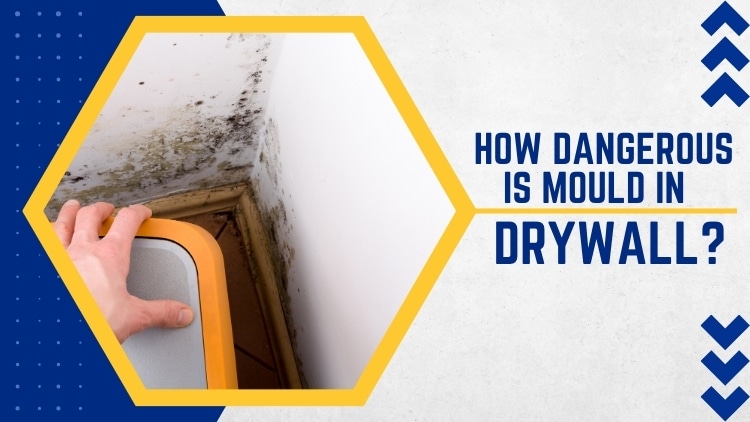We offer a wide range of services for that fresh look, or just maintenance or updates to keep your home functioning and safe. Regardless of the size of the job, we have a craftsman that can tackle it. We offer a wide range of services for that fresh look, or just maintenance or updates to keep your home functioning and safe. Regardless of the size of the job, we have a craftsman that can tackle it.

Drywall / January 27, 2024

With all the buzz around mould and its potential health hazards, homeowners are understandably concerned about its presence in their homes. However, it isn’t always easy to detect, and it can thrive in hidden areas of your home, including behind your drywall. But how dangerous is it? Our experts at Handyman Connection in Red Deer have weighed in, and the answer might surprise you.
Mould can pose a serious threat to your health, particularly if you have allergies or respiratory issues. In addition, it can cause damage to your drywall, which can weaken the structural integrity of your home. If you’re looking for “residential drywall services near me,” it’s important to work with a professional who can assess and address any issues that may be present. Keep reading to learn more about the risks of moisture in your walls and how our team can help keep your home safe and healthy.
With beautiful finishing and impeccable colour schemes, your drywall does more than just add aesthetic value – it shelters you and your loved ones. Yet, this sturdy façade can hide a rising concern, moisture. As our Handyman Connection experts reveal, it isn’t just a cosmetic flaw, it’s a potential health risk and a threat to the structural integrity of your home.
What is it?
Drywall mould, often mistaken as a mere stain or discolouration, is a widespread problem which arises due to moisture accumulation in your wall cavities. Whether it’s leftover dampness from a flood, a leaky pipe, or high humidity levels, your walls become a fertile breeding ground for spores to grow and spread.
Why can’t it be ignored?
Unfortunately, what appears as a simple patch on your wall, can signify an underlying vast network of fungi, compromising your health, and slowly eating away your home’s structure. Ignoring it doesn’t mean it’s gone, it multiplies, brings along a host of problems, and could potentially make your house unsafe to live in.
What makes drywall a hotspot?
The construction material, drywall, is known for its durability and low cost, making it a preferred choice for homeowners. However, it’s this same characteristic that makes it a hotspot for fungi growth. Its porous nature and cellulose content can trap moisture and provide ample food. When the conditions are right, spores, which are naturally present in the environment, latch onto the drywall, exploiting the moisture and cellulose, and thus, begin their destructive journey.
As our Handyman Connection experts put it, awareness and quick action are your best defences.

Your health should never be compromised for any reason — and that includes exposure to anything in your drywall. Let’s dive in to uncover the potential health risks that this seemingly harmless fungus can bring.
Respiratory Complications
Mould is a silent, deadly airborne predator. It finds its way into your respiratory system, where it can wreak havoc. Short-term effects resemble allergy symptoms: runny nose, itchy eyes, coughing, and skin irritation. However, prolonged exposure can lead to serious complications such as bronchitis, pneumonia, and other chronic respiratory diseases. Those with asthma or weakened immune systems are particularly vulnerable.
Skin Irritation
Unbeknownst to many, damaged, moist, or walls with mildew can also cause skin irritations. You may experience redness, itching, or see rashes appear on your skin. Touching mouldy drywall can also trigger these effects, so keep your hands off.
Mental Health Implications
Research suggests that exposure to mould spores in your environment can even impact your mental health. There have been cases attributed to depression and other mood disorders. The linkage is not fully established, but the possibility itself should not be overlooked.
A Toxic Phenomenon: Mycotoxins
Some species produce toxic substances known as mycotoxins. These can lead to neurological problems and, in rare cases, death. Young children, the elderly, and those with weakened immune systems are the most susceptible.
Remain vigilant, keep your eye out for signs of fungi growth. Your health and your home’s well-being depend on it.
Often, people underestimate the devastating impact that mould can have on the structure of a home. Beyond the health risks, it can be a formidable enemy to the structural integrity of your house, particularly if it finds its way into your walls. Let’s shed some light on this often-overlooked issue.
Drywall Degradation
Mould grows by producing enzymes that break down organic matter. This is a natural part of the decomposition process in nature. However, when it grows on drywall, it breaks down the organic compounds in the gypsum and the paper that covers it. As it feeds on these materials, it weakens it, making it crumble and collapse over time. Damage may not always be visible on the surface, but beneath the paint and wallpaper, there could be rampant decay.
Mould Breeds Moisture
The relationship between mould and moisture is cyclical – it creates a damp environment, which in turn encourages more growth. Wet or damp drywall is inherently weaker and more prone to breaking down, meaning infested pieces may become increasingly moist and fragile. This chain reaction can accelerate the deterioration of your home’s structure, leading to costly and extensive repairs.
Compromised Insulation Efficiency
Affected drywall can negatively impact your home’s insulation efficiency. Given that mould thrives in humidity and warmth, it could mean your insulation isn’t functioning as it should, allowing more heat or cold air to penetrate your home. This inefficiency can lead to an increase in your energy bills and an uncomfortable living environment.
Remember, dealing with mould isn’t just about maintaining your home’s aesthetics or your health; it’s also about preserving the value and structural integrity of your property.
It’s crucial that you identify moisture quickly and take prompt action to mitigate it. Ignoring it can bring drastic health problems and structural damage to your home. So, how can you spot it thriving in your drywall? Our Handyman Connection Red Deer professionals offer the following insights:
Signs
Remember, ignoring it will not make it disappear. Instead, you’ll end up dealing with higher costs for removal and repair, and potentially, severe health issues. Be proactive for the health of your home and family.
Engaging the services of a Handyman Connection professional will yield the best results when dealing with an infestation on your drywall. Our Red Deer experts are equipped to promptly assess and effectively eliminate fungus growth, thereby restoring peace and health to your home.
When to Call a Professional
The resilience of mould and its mode of spread requires skillful intervention, especially considering its potential health hazards. As soon as you notice a black or greenish-black growth on your walls or a persistent musty smell, don’t hesitate to call a Handyman Connection professional.